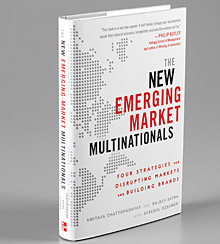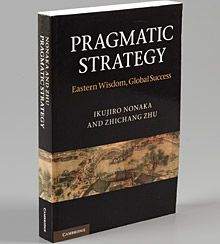Best Business Books 2012: Strategy
Considering Competition
(originally published by Booz & Company)
Amitava Chattopadhyay and Rajeev Batra, with Aysegul Ozsomer
The New Emerging Market Multinationals: Four Strategies for Disrupting Markets and Building Brands
(McGraw-Hill, 2012)
Ikujiro Nonaka and Zhichang Zhu
Pragmatic Strategy: Eastern Wisdom, Global Success
(Cambridge University Press, 2012)
Benoit Chevalier-Roignant and Lenos Trigeorgis
Competitive Strategy: Options and Games
(MIT Press, 2011)
In 2005, only 44 of the companies on Fortune’s Global 500 list were from emerging markets. In 2010, there were 113 emerging-market companies on the list, an increase of more than 150 percent. What led to this significant increase in just five years?
That’s the question taken up in this year’s best business book on strategy, The New Emerging Market Multinationals: Four Strategies for Disrupting Markets and Building Brands, by Amitava Chattopadhyay and Rajeev Batra with Aysegul Ozsomer, professors at INSEAD, the University of Michigan, and Koç University in Istanbul, respectively. In a strong field, the book stands out for taking on the important topic of global competition, and presenting original findings in a manner that’s engaging and accessible to practitioners.
The authors’ central argument is that the new generation of emerging-market multinational companies represent a trend that will transform the global economy. These EMNCs (the authors’ abbreviation) are no longer content to play a secondary role in their industry. They have, write the authors, “the ambition, vision, and confidence to want to become global giants themselves.” Some of them, such as South Korea’s LG Electronics and China’s Lenovo, have been well known for years. Others, including India’s Wipro, Taiwan’s HTC, and China’s Haier, have only recently raised their global profile. And still others are just starting their ascent to the global stage; these include India’s Apollo Tyres, Turkey’s Arçelik, and Brazil’s Natura Cosmeticos. If the current trend continues, the list of high-performing companies from emerging markets will grow, and extend to more and more industries.
For some established multinational corporations (MNCs), The New Emerging Market Multinationals will explain the strategies being followed by new competitors that are already roiling their markets. For others, the book offers a glimpse of the future, in which their competitors will come from all over the world. For EMNCs aspiring to succeed in the global arena, the book explores the immense strategic challenges to come. Not only must they compete against large and established incumbents, but they must overcome disadvantages, some real and others perceived, associated with image, brand, and culture. Any successful strategy must not only neutralize the advantage of incumbents, but find new sources of competitive advantage. Hence the reference to disruption in the book’s subtitle.
The book debunks the idea that today’s EMNCs are succeeding only because of advantaged cost positions or generous resource endowments. The authors identified four strategies in the course of their research, which included the study of 39 EMNCs, not only from the largest emerging economies such as Brazil, China, India, Korea, Mexico, and Turkey, but also from Guatemala, Jordan, Taiwan, Thailand, and more.
Two of the strategies are familiar. Some EMNCs are indeed the stereotypical cost leaders, using their advantaged cost structures, often related to wage differentials, to achieve competitive success in new markets. Others are knowledge leveragers, drawing upon their understanding of home country customers to achieve success elsewhere, perhaps following the diaspora of home country emigrants.
More interesting are the growing numbers of EMNCs pursuing a third strategic path. They are seeking to employ their particular advantages of knowledge and innovation while avoiding direct competition with powerful incumbents. These niche customizers identify specific customer segments, often small and apparently unattractive within larger markets, where they can use their expertise to establish strong beachheads and eventually expand their positions. An example is Mahindra & Mahindra Ltd., which used its expertise in producing small tractors in India to expand into the niche markets of lawn care and golf course maintenance in the United States and Australia. Similarly, Haier chose not to enter the U.S. market with large refrigerators, but instead went after the niche market for small refrigerators, suitable for dormitory rooms or wine cellars, and only later expanded its product line.
The fourth strategy, that of global brand builders, represents the most dramatic approach. Just a few years ago, many EMNCs either were original equipment manufacturers or sold low-value branded products. Today, many of these companies have developed global brands known for their high quality, including not only familiar names like HTC and Wipro, but also, as noted earlier, Natura Cosmeticos and Apollo Tyres. This transformation is especially ambitious, but it holds the promise of the highest margins and a position of parity with the best companies in the world.
The authors contend that to succeed on the world stage, EMNCs aspiring to be global brand builders face two challenges: one concerning the need to establish a business of global scale, and the other related to building a global brand. “Without a sustainable global business model, building a global brand is a waste of time and resources,” they write. “On the other hand, a global business built on an unbranded commodity basis is not likely to be very profitable or sustainable long term.” Both are essential and each one reinforces the other, yet they require very different capabilities, confront different obstacles, and move at different rhythms.
One might argue that all MNCs, no matter their country or era, have faced these twin challenges, but the authors think that the challenge facing EMNCs today is greater. Achieving global scale in the 21st century, when incumbents are already large and well developed, calls for particular care. For some, it means avoiding direct confrontation by expanding first in peripheral markets; for others, it involves large and complex acquisitions, such as Apollo Tyres’ acquisition of Dunlop, Tata Motors’ purchase of Daewoo Trucks and Jaguar, and Lenovo’s takeover of IBM’s personal computer division. Developing a global brand, meanwhile, calls for a step change in how an EMNC presents itself and is perceived by customers around the world.
Not surprisingly, the authors, who are marketing professors, devote much attention to the topic of brand building. But they are wise to note that without a solid organization to back it up, efforts to establish a powerful brand will eventually come to naught. Creating a sustainable business model is achieved through the hard work of attracting and retaining talent, of pursuing innovation and quality, and of building processes that can handle daily tasks including procurement, logistics, and sales. They quote Priti Rajora, Wipro’s head of talent management, who commented that one of Wipro’s greatest challenges was to evolve from being an Indian company to being one in which any employee from anywhere in the world had an equal opportunity to rise within the company.
Such a view is especially important in light of recent history. Looking back just one generation, several Japanese companies, including Matsushita and Toyota, succeeded in creating brands with global appeal and shattered the “low quality” image of Japanese products. But they struggled to solve the problem of attracting and retaining local talent, and to become global in outlook. A new crop of EMNCs would do well to acknowledge how one source of strength — a strong and distinctive culture — can become a limitation on the broader global stage.
The New Emerging Market Multinationals is an important addition to the strategy bookshelf because it helps us understand the logic behind the rise of companies from emerging markets, including many new powerhouse firms in electronics, vehicles, services, healthcare, and other industries. The book serves a broader purpose as well, and reminds us of eternal strategic questions, such as how to identify, develop, and sustain a competitive advantage in crowded and unforgiving fields.
Confucius Says
A complementary perspective is provided by Pragmatic Strategy: Eastern Wisdom, Global Success, by Ikujiro Nonaka, professor emeritus of Hitotsubashi University’s Graduate School of International Corporate Strategy, and Zhichang Zhu, a lecturer in management at the Hull University Business School in the United Kingdom. Like the authors of The New Emerging Market Multinationals, Nonaka and Zhu cite evidence of the tectonic shift in global competition caused by the growing number of emerging market multinationals, in particular mentioning those from East Asian nations. But rather than looking to business activities — such as brand building, market segmentation, and leveraging of capabilities — to explain this trend, Nonaka and Zhu examine the broader societal elements of culture and philosophy.
Is the rise of EMNCs, and the development of the economies from which they come, testimony to some wisdom shared among Eastern cultures? Conversely, are the recent problems in the West, including debt crises, financial meltdowns, and economic stagnation, linked to flaws in the philosophies that underpin their societies? It is an intriguing thesis and well worth exploring, in part to better appreciate the fact that strategy is a reflection of, and embedded in, a larger context.
The authors illuminate the relationship between strategic action and its social context through a sweeping examination of ideas in Eastern and Western philosophy and literature. As the book’s title suggests, their central focus is pragmatism, by which they mean “the purposeful accomplishment of idealistic, informed, disciplined experimentation” that blends a sense of purpose and idealism with flexibility. “Pragmatism is not anything goes or opportunism without purpose,” they write. Rather, it requires learning and sound judgment.
Pragmatic strategies, say Nonaka and Zhu, succeed due to “sheer down-to-earth vigilance and flexibility.” The authors contend that pragmatism is rooted in Confucian thinking, and they find more recent evidence of it in modern Chinese reforms, citing catchphrases, such as “crossing the river by touching stones,” and Deng Xiaoping’s dictum that the color of a cat is of no matter so long as it catches mice.
At the heart of the book, the authors discuss three tenets of “enduring Confucian wisdom”: Wuli (the material–technical), Shili (the cognitive–mental), and Renli (the social–relational). Wuli, which focuses on technical efficiency, involves getting the fundamental elements of the organization working well together. Shili, which is concerned with creativity, provides a vision of a desired future. And Renli, which speaks to the value of social legitimacy, concerns achieving common goodness.
Rather than following a linear logic of setting goals and taking action, or ends driving means, these three concepts are mutually reinforcing, and each can be seen as a point of departure. When approached properly, pragmatic strategy creates a balance among the three, say the authors, that generates value “efficiently, creatively, and legitimately by getting fundamentals right, envisioning a valued future and realising common goodness.” Harmony and balance are the keys to success here; efforts to emphasize one tenet over the others will fail. Thus, strategies based on narrow financial goals or notions of efficiency that ignore social and human consideration are not only incomplete, but ultimately self-defeating.
The authors find evidence of pragmatism in Asian companies, including Honda, Canon, Lenovo, and Haier. They also discuss Nobel Peace Prize joint winners Muhammad Yunus and Grameen Bank. The revolutionary microfinance bank Yunus founded in Bangladesh is a notable example of pragmatism because of its willingness to adapt and experiment, according to the authors. But they recognize that pragmatism is not the exclusive domain of the East. It is present in the thinking of Aristotle, for example, and they note that it also resembles what Jerry Porras and Jim Collins called “core values” in their influential book Built to Last: Successful Habits of Visionary Companies (HarperBusiness, 1994). Indeed, among the first exemplars of successful pragmatism cited in Pragmatic Strategy are Bill Gates of the Microsoft Corporation and Michael Dell of Dell Inc., smart entrepreneurs whose important influences probably did not include Confucius, but whom the authors nonetheless highlight for their willingness to experiment and adapt.
In the concluding chapter of this scholarly and probing book, the authors suggest that Shared Wisdom, Global Success might have been a better subtitle. Principles of balance and a goal of achieving common goodness are indeed crucial in today’s world, and reminding ourselves of the shared wisdom that underpins managerial action is of high importance.
Yet for all its strengths, I still have a few quarrels with this book. The recent growth of emerging economies might seem to be the result of pragmatic policies, but it’s worth recalling that Deng’s comment about the color of a cat was meant as a corrective to years of doctrinal Communist ideology, which was itself a reflection of Chinese thinking. Indeed, Confucianism is often connected with ideas such as obedience, hierarchy, duty, and filial piety, hardly what we associate with pragmatism. Current successes notwithstanding, it is questionable whether China’s emphasis on central initiatives, like its succession of five-year plans, is better understood as a reflection of pragmatism or as evidence of a traditional Chinese emphasis on hierarchical direction. Further, almost any example of success can be described as the result of pragmatism. Terms like core vision and balance and adaptability are easy to infer ex post when companies are successful, but are conspicuously absent when companies fail.
These concerns notwithstanding, Pragmatic Strategy remains a fascinating book that spurs us to think about strategy in its broader philosophical context, and advances important hypotheses about the values and ideas behind the growing success of companies with roots in Confucian thinking.
Option Games
An equally scholarly book, but one that addresses a very different aspect of strategy, is Competitive Strategy: Options and Games, by Benoit Chevalier-Roignant, a researcher at University of Texas at Dallas, and Lenos Trigeorgis of the University of Cyprus, one of the leaders in the field of real options. For readers interested in the theoretical underpinnings of competition and strategic choice, it’s an important contribution to the field as well as an engaging book.
The authors explore two theoretical traditions — game theory, which comes from economics, and real options, which traces its roots to finance — and show how their insights can inform many kinds of strategic decisions. Game theory, of course, has long contributed to our understanding of moves and countermoves in competitive situations. More illuminating for many readers will be the treatment of real options, which is a more recent theoretical development, but can help managers think in terms of the sequence of decisions they make over time.
Many kinds of options, such as puts and calls in the stock market, can be traded in financial markets, but the distinguishing feature of real options is that they cannot be traded. Instead, they are opportunities that accrue only to the owner of an asset, and include decisions such as whether to expand an existing plant or close it and build a new one. Whereas traditional analysis of decisions like these has employed calculations made at a fixed point in time (such as net present value and discounted cash flow), the contribution of real options is to introduce a temporal dimension and show how strategists can respond flexibly as circumstances change.
Most compelling, as well as original, is an integrative approach to strategy that combines the two approaches, which Chevalier-Roignant and Trigeorgis call “option games.” Real options help illuminate the decision to invest or expand, and the addition of game theory adds the competitive dimension, as each player’s moves take into account the actions of rivals.
Competitive Strategy is replete with mathematical formulas and discussions of theory that can be daunting, but the authors do several things that make the book a worthy read for all strategists. First, they offer many examples from the business press to ground the book in real-world decisions. They illustrate the problem of how best to expand capacity, for instance, by citing Virgin Atlantic’s choice in 2004 to double its fleet with the purchase of 13 Airbus 340s, large four-engine aircrafts, in an effort to match rival British Airways in scope, and Air Canada’s choice in 2005 to purchase the Boeing 787 Dreamliner for its superior fuel efficiency on long-haul flights. The decisions the companies made were very different: Virgin preferred a large, lump-sum capacity expansion; Air Canada followed an incremental and flexible approach. But both can be understood by the combined power of game theory, which considers competitive forces, and the insights of real options, which examine sequences of decisions over time.
Second, the authors provide brief interviews with leading thinkers in game theory and real options, including Princeton economist Avinash Dixit and Nobel laureates Reinhard Selten and Robert Aumann. These interludes provide additional perspective and help illuminate key concepts, as well as adding personal and idiosyncratic accounts of their careers. The result is that the reader gains a sense of how the field has developed and an appreciation of how two separate strands of thinking, one from economics and one from corporate finance, can inform strategic decisions.
Competitive Strategy, like Pragmatic Strategy, is rich with ideas that will stretch and challenge the reader. The New Emerging Market Multinationals is less intellectually demanding but perhaps more immediately practical. What the three books share, however, is a willingness to bring fresh thinking to some of the most important questions of global competition and business strategy. ![]()
Author profile:
- Phil Rosenzweig is a professor at IMD in Lausanne, Switzerland, where he works with leading companies on strategy and organization issues. He is the author of The Halo Effect...and the Eight Other Business Delusions That Deceive Managers (Free Press, 2007).




